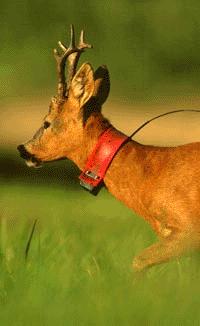
A territorial male during the summer rut in a grassland; animals were marked with uniquely colored collars fitted with a radio tag and a whip antenna. Instead of wandering around aimlessly, most animals tend to stay in a certain area –known as their home range. Understanding an animal's home range has been a central focus of ecological research since Darwin's time. But while explaining why different sized species need different amounts of space is relatively easy, a study from the October issue of The American Naturalist tackles a much more complex question: what determines differences in home range size among individuals of one species?
Luca Börger (Imperial College London, Silwood Park Campus, University of Cambridge, and Universita di Siena) and his colleagues spent four years monitoring the movements of a roe deer (Capreolus capreolus) population in the Maremma Regional Park in southern Tuscany. They found that animal home ranges are an outcome of complex interactions between the behaviour of the animals and the environment.
"By incorporating the different layers of 'complexity' we found a simple explanation for our deer, which contrasts with several common assumptions about roe deer behavior," Börger explains.
Neighboring animals differ in the amount of area they use depending on the most abundant habitat type inside their home range. The deer also respond to day length, with small home ranges in the summer and larger areas in autumn and winter.
"Yet, if it rains less or it is hotter than usual, the animals range over wider or smaller areas, depending on the habitat they are in," adds Novella Franconi (Universita de Siena).
The method can be applied for facilitating comparisons across populations and species. "This is not only of scientific interest," concludes Tim Coulson (Imperial College London, Silwood Park Campus), "but is increasingly important to manage the effects of climate change and habitat alterations on animal populations." Source : University of Chicago Press Journals
 Print Article
Print Article Mail to a Friend
Mail to a Friend
